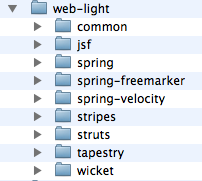Last week, I attended a talk by Jason van Zyl on Comprehensive Project Intelligence. This talk contained a good overview of some Maven goodies that Jason's company has been working on - namely better repository management (Nexus), better Eclipse support (m2eclipse) and improving an awesome CI server (we use Hudson heavily at LinkedIn).

Photo by Toshio
It looks like Jason is going to be doing a similar session in a full-day format at ApacheCon next week. The good news is it's free, the bad news is you have to be in New Orleans. Hopefully Jason and team will post their slides from this event and we can all learn how to use Maven more effectively.
In other Maven-related news, I hope to complete AppFuse 2.1 around the same time as Spring 3.0 (early next year). As part of that release, I hope to start using Nexus for AppFuse's repository as well as restructure its archetypes to allow using m2eclipse (with WTP) more effectively.
Last night, I stayed up into the wee hours of the morning working on something I've been wanting to do for a long time. It wasn't until I was trouncing around the woods in Montana that I realized how easy it would be. The something I've wanted to do was to modify AppFuse Light to use AppFuse's core modules (service and dao). It only took me a few hours to make it happen and it inspired additional ideas.
I believe the major mistake we made in AppFuse 2.x was making it easy for user's to upgrade their applications. We currently use the maven-war-plugin and our own maven-warpath-plugin to make it possible to include AppFuse classes and assets in your project. You can easily start a new project w/o having a whole bunch of files in your project. The problem is, you can't easily use "mvn jetty:run" to work on your project. Of course, you can use "mvn appfuse:full-source" to solve this, but I'm starting to think more and more that "full-source" should be the default. This is what we did in 1.x and it seems to be the more natural pattern for folks using AppFuse.
That hard part about moving to "full-source" by default is coming up with a way to share common assets and classes among wars and war projects. Sure, I can copy all the shared images, css and js
into each project - but that could become a maintenance nightmare. Subversion 1.5 with relative svn:externals might solve this, but it still seems kinda hacky. I don't want to use the maven-war-plugin because the overlay is kinda hokey and I think it's easier for users to understand when everything
is in their project.
AppFuse's current directory structure in SVN looks as follows. I've added indicators of what is in each directory.

Rather than using AppFuse's current (manual) archetype-creation process, I'd like to move to a more automated creation process using the maven-archetype-plugin's create-from-project feature. I'd like to figure out a way where I can have the source code and assets from web/common included in each of the other web/* projects (both when using "jetty:run" and "archetype:create-from-project"). One idea I thought of is to make
Jetty/Maven aware of multiple src/war directories for "jetty:run" and "package" and then
somehow hook into the archetype plugin at creation time to pull in the
shared resources. I don't know if something like this is possible. If you know of a good solution to this shared web assets issue, I'd love to hear about it.
Back to AppFuse Light. If I can figure out how to solve shared resources in web modules, I can use this in AppFuse Light to move to a modular SVN structure vs. its current "use Ant to create different combinations" setup. If a modular structure (like appfuse/web/*) is possible for AppFuse Light, I believe it makes sense to move its source into AppFuse's SVN repository. Below is how the directory structure might look after this move.

With this addition and "archetype:create-from-project", we should be able to create all the basic and light archetypes automatically. We'll probably still need a manual archetype-creation process for modular archetypes, but I'm OK with that.
The last thing I'm struggling with is figuring out the best way to create archetypes for something like AppFuse. In the past, we've used dependencies to allow users to inherit dependencies and their versions. This works, but it results in a lot of duplicate XML (in projects and archetypes) for developers. Last night, I tried using a parent project instead of dependencies and it seems to work much better. Not only do you inherit dependencies, but you also inherit plugins, profiles and properties. If you inherit, you can override, which is slick.
If you're an AppFuse user, how would you feel about having an AppFuse module as your project's parent? Would you prefer that, dependencies on AppFuse or full-source with no dependencies on AppFuse? Regardless of parent vs. dependencies, I think running "appfuse:full-source" should allow you to de-couple your project from AppFuse.




